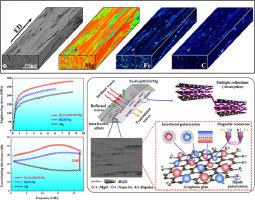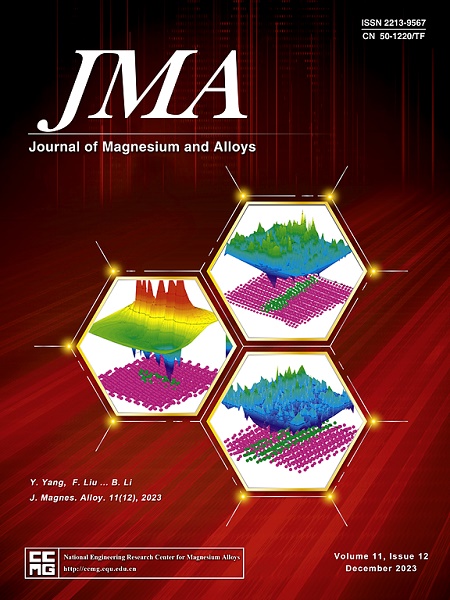通过原位界面反应和异质结构设计打破镁基复合材料的性能权衡
IF 15.8
1区 材料科学
Q1 METALLURGY & METALLURGICAL ENGINEERING
引用次数: 0
摘要
镁基复合材料的许多性能互不兼容,甚至完全相斥。在这里,我们通过原位界面反应策略,在用还原氧化石墨烯(RGO)增强的镁基复合材料中构建了磁性层状成分,实现了复合材料强度、延展性和电磁屏蔽性能的同步提高。磁性成分是由封装在 RGO 上的 Fe2O3 纳米颗粒与镁基体原位反应产生的。卓越的强度-电导率协同作用源于分层异质结构,它激活了非基底位错,并实现了稳定的微裂纹增殖。异质层状结构增强了复合材料内部电磁波(EMW)的多级反射。原位界面反应为复合材料引入了丰富的异质界面,提高了复合材料的界面极化损耗能力。磁性 RGO 层可提供打破斯诺克极限的形状各向异性,从而提高复合材料在高频电磁场中的磁损耗能力。多种电磁波损耗机制的协同作用提高了复合材料的电磁屏蔽性能。本研究强调了界面结构对复合材料机械和功能特性的影响,为开发性能更强的结构/功能一体化复合材料提供了一种可行的方法。本文章由计算机程序翻译,如有差异,请以英文原文为准。

Breaking Mg matrix composite property trade-offs via in-situ interface reaction and heterogeneous structure design
Many properties of Mg matrix composites are mutually incompatible, and even completely repel each other. Here, we constructed a magnetic layered component in Mg matrix composite reinforced with reduced graphene oxide (RGO) through an in-situ interface reaction strategy, achieving simultaneous improvement in the strength, ductility, and electromagnetic shielding performance of the composite. The magnetic component is generated by the in-situ reaction of Fe2O3 nanoparticles encapsulated on RGO with the Mg matrix. The superior strength-ductility synergy originates from layered heterostructure, which actives non-basal dislocations and enables a stable microcrack-multiplication. The heterogeneous layered structure strengthens the multi-level reflection of electromagnetic wave (EMW) inside the composite. The in-situ interfacial reaction introduces abundant of heterogeneous interfaces into the composites, which improves the interfacial polarization loss ability of the composites. The magnetic RGO layer can provide shape anisotropy that breaks the Snoek limit, thus improving the magnetic loss ability of composite in high-frequency electromagnetic fields. The synergistic action of multiple EMW loss mechanisms improves the electromagnetic shielding performance of composite. The current study emphasizes the influence of interface structure on the mechanical and functional properties of composites, and presents a promising approach for the development of structure/functional integrated composites with enhanced properties.
求助全文
通过发布文献求助,成功后即可免费获取论文全文。
去求助
来源期刊

Journal of Magnesium and Alloys
Engineering-Mechanics of Materials
CiteScore
20.20
自引率
14.80%
发文量
52
审稿时长
59 days
期刊介绍:
The Journal of Magnesium and Alloys serves as a global platform for both theoretical and experimental studies in magnesium science and engineering. It welcomes submissions investigating various scientific and engineering factors impacting the metallurgy, processing, microstructure, properties, and applications of magnesium and alloys. The journal covers all aspects of magnesium and alloy research, including raw materials, alloy casting, extrusion and deformation, corrosion and surface treatment, joining and machining, simulation and modeling, microstructure evolution and mechanical properties, new alloy development, magnesium-based composites, bio-materials and energy materials, applications, and recycling.
 求助内容:
求助内容: 应助结果提醒方式:
应助结果提醒方式:


